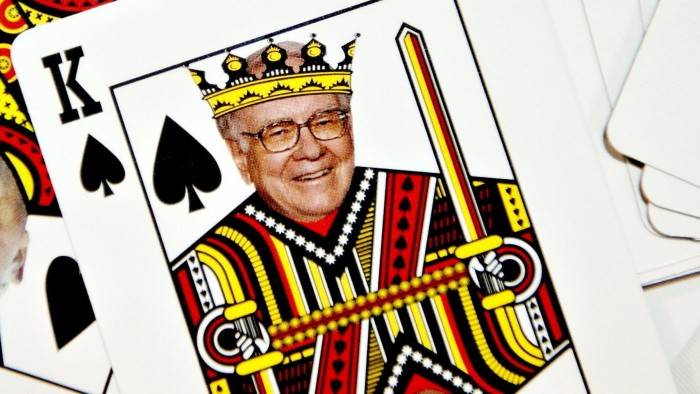
Unlock the Editor’s Digest for free
Roula Khalaf, Editor of the FT, selects her favourite stories in this weekly newsletter.
As I get older I find there are many things I do less well. Fortunately, there are a few things — very few — I do better. One of them is playing bridge.
When I retired from running global equity funds at Artemis last year I had the chance to play many more games. Now I am returning to fund management, I will have less time, but I have no plans to stop entirely — a similar approach to Warren Buffett, famed investor and keen bridge player.
It may sound strange, but I believe that playing bridge makes me a better investor. It probably works similar brain muscles. Both pastimes rely, to some extent, on you recognising patterns and responding appropriately.
“The art of being lucky” is the subtitle of Victor Mollo and Nico Gardener’s guide on how to play the cards in bridge. The phrase is ironic. The point is that what seems to be luck arises from good technique, which comes with practice and experience.
The book goes through “finesses”, “squeeze plays” and “coups”. Some of these, such as the “Vienna coup” and “backwash squeeze”, are card plays dating back to the 19th century. Seeing how these classic plays work is one thing — remembering when to use them is quite another.
In bridge there are four players in two partnerships, but no player knows at the outset which cards their partner holds. The game starts with players taking turns to call bids to specify how many “tricks” their partnership needs to win to receive points.
Don’t worry, this is not turning into an instruction manual. All you need to know is that the more tricks you predict winning, the more high cards you will need to hold. So setting the right objective makes all the difference to how the game goes.
FT Bridge column
The FT’s weekly bridge column
This has echoes for professional and everyday investors alike. Do not target higher returns than markets seem likely to deliver — you will end up taking on too much risk to achieve them and only enhancing your likelihood of spectacular failure.
Do not aim for a yield on your portfolio if the selection of good companies paying high yields is poor — you will end up compromising on quality. And do not adopt a deep value approach to investing when markets do not have plenty of stocks trading below book value. As long as you set yourself an objective that follows from the cards you are dealt, the play of the hand is much easier.
A corollary of this for me, as a fund manager, is that different market conditions will suit different investment styles. To deliver performance consistently you have to adapt — and here experience can be useful in recognising how best to anticipate or respond to changing conditions.
I think this flexibility is important. But it is surprising how many managers these days refuse to bend. They have a very specific way of running money and cannot change. Fund managers used to be more flexible and, I would argue, sensible.
However, as large fund houses have become more systematic, team led and driven by the demands of process-obsessed institutional investors, this has changed. It means that in a lot of cases you, the investor, now have to make the decision to switch managers if you believe the wind is going to be against their approach for any significant amount of time.
Bridge also has a similar cast of characters to the investment world. There are the eternal optimists, who think that every finesse will work and that their opponents’ kings will fall under their aces like raindrops. And there are the eternal pessimists, who believe any card they play will be trumped by the opposition and that the distribution of the cards between opponents’ hands will always be troublesome.
Unhedged podcast

The Magnificent 7 make up seven of the eight largest stocks on the S&P 500. Rob Armstrong and guest John Foley, who covers technology for the Lex column, take a look at all seven. Listen here
In the world of investment, similarly, there are managers who will tell you that everything is rosy and that all their investments are not just world-beating companies but entirely unappreciated and undervalued. There is also a group of investment houses that seem to revel in predicting doom, unexpected surges in inflation and the collapse of financial markets. Do not pay too much heed to any of them!
Looking at the cards in our hands currently, it seems to me that the equity market offers neither in the sunshine nor rain. Companies are increasing their cash flows steadily, and inflation and interest rates in most of the major economies are falling — normally the basis for taking a positive long-term view.
The main worries in the investing world are geopolitical. These risks are always present and should be taken seriously. But it is also unwise to go into a funk because there is a war on. As in bridge, keeping a clear head is key — and triumphs and disasters cannot be allowed to unsettle you.
As an investor, I think my biggest concern is how much I am paying for a stock. Buffett proffered a couple of now popular epigrams in this regard. The first is: “Price is what you pay; value is what you get”; and the second is “it’s far better to buy a wonderful company at a fair price than a fair company at a wonderful price.”
Looking at today’s market, I feel many passive investors are being driven to buy some wonderful companies at prices that do not represent fair value — or anything close to it. The expensive Magnificent Seven behemoths now dominate indices to such an extent that I fear for future returns.
Indeed, it is a factor in my being lured back to work. I do not think I can remember a greater opportunity for active managers to demonstrate the value they can bring through intelligent, balanced stockpicking.
Not long ago Buffett celebrated his 94th birthday. He is still working and still playing bridge eight hours a week. If I keep playing the game for as long as he has, maybe my investment performance will get to be as good.
Simon Edelsten is chair of the investment committee at Goshawk Asset Management

